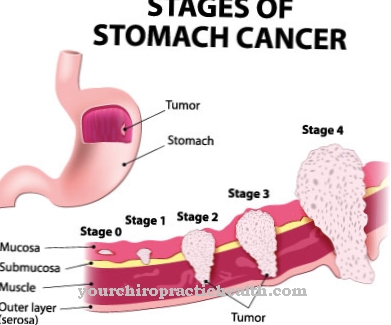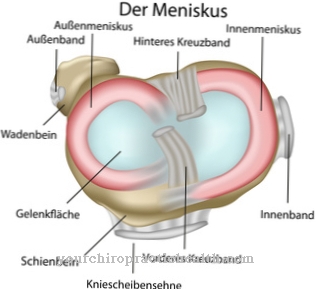In the Von Gierke disease it is the most common glycogen storage disease.The disease is characterized by the unusability of the glycogen reserves in the liver. However, the stored glycogen in the muscles is not affected.
What is Von Gierke Disease
The Von Gierke disease was first described by the doctor Edgar von Gierke in 1929. In this disease, the glycogen stored in the liver can no longer be used due to a genetic defect. A few hours after eating, there is a dangerous drop in blood sugar level, which must be immediately compensated for by quickly available carbohydrates.
Glycogen is a polysaccharide like vegetable starch, which is broken down into monosaccharides during periods of abstinence from food and is returned to the body in the form of glucose. In addition, this breakdown keeps the blood sugar level constant. Due to a mutation, the responsible enzyme glucose-6-phosphatase is no longer produced sufficiently or only in an inactive form. This genetic defect is inherited in an autosomal recessive manner.
The disease is very rare. Only about one in 100,000 newborns suffers from this disease. However, Von Gierke's disease is the most common glycogen storage disease. It is also known as glycogen storage disease type I (GSD1) or glycogenosis type I. However, the syndrome can still be divided into types Ia and Ib. Type Ia is 80 percent and, accordingly, Type Ib is 20 percent.
causes
Von Gierke disease in type Ia is a genetic defect in the G6PC gene on chromosome 17 and in type Ib a genetic defect in the SLC37A4 gene on chromosome 11. Both gene mutations are inherited in an autosomal recessive manner. In type Ia, the enzyme glucose-6-phosphatase is no longer sufficiently available or is ineffective due to a defect. This enzyme is responsible for breaking down glucose-6-phosphate, releasing glucose and the phosphate group.
Glucose-6-phosphate is a metabolite in the chain from glycogen to glucose. The lack of dephosphorylation of this compound prevents glucose from being formed. It just initiates the further synthesis of glycogen. The glycogen store in the liver fills up more and more. This leads to their enlargement (hepatomegaly). At the same time, the blood sugar level can no longer be balanced. After the meal, the blood sugar is carried into the cells for combustion by the action of insulin.
When blood sugar becomes too low, more glucagon, the antagonist of insulin, is formed. Glucagon takes care of the breakdown of glycogen reserves in the liver and muscles. If the enzyme glucose-6-phosphatase is defective, glucagon can no longer induce the formation of glucose from glycogen.
In Von Gierke's disease of type Ib, another enzyme is primarily affected by a defect. It is a transport enzyme for glucose-6-phosphatase. Glucose-6-phosphatase is intact here, but cannot be transported to its destination, the liver.
Symptoms, ailments & signs
Von Gierke's disease is characterized by hepatomegaly (enlargement of the liver), increased blood sugar levels after eating and greatly reduced blood sugar levels after three hours of abstinence from food. At the same time, there is an increased uric acid level and increased triglyceride levels in the blood. If there is no food intake, hypoglycemic convulsions occur.
The disease is noticeable in children as early as three to four months of age. Growth is delayed. At the same time, osteopenia or osteoporosis occurs. The face appears round with full cheeks. In addition to the liver, the kidneys are also enlarged. In addition, frequent nosebleeds occur due to platelet dysfunction.
In type Ib there are also functional disorders of the neutrophils. That is why infections and intestinal inflammation develop frequently. Liver dysfunction due to liver adenomas or even liver carcinoma can occur as late complications. Renal insufficiency can also develop.
Diagnosis & course of disease
Von Gierke's disease can be diagnosed very well by the typical course of the blood sugar curve in connection with the lactate level. Hyperglycemia and hypolactic acidemia are always present immediately after meals. After three to four hours of food abstinence, the blood sugar level is too low and the lactate level is too high for that.
The hypoglycaemia in Von Gierke disease is always fast-dependent. The activity of glucose-6-phosphatase is only rarely determined today. This is because molecular genetic examinations eliminate this need. In the differential diagnosis, liver tumors can be ruled out using imaging techniques. The other glycogenoses can also be clearly distinguished because they show high blood sugar levels and high lactate levels after meals and accordingly low blood sugar levels and low lactate levels after three to four hours.
Complications
In Von Gierke's disease, patients primarily suffer from severe liver enlargement. This can also cause pain as the liver presses on the other organs. Heavily reduced blood sugar levels also occur due to illness and have a very negative effect on the quality of life of the person affected.
The patients are not able to perform strenuous activities or sporting activities and often feel tired or exhausted. Von Gierke's disease also significantly reduces resilience. People suffer from cramps in the muscles and, in many cases, from nosebleeds. The disease can also lead to inflammation in the intestine or liver. In the worst case, a tumor forms in the liver.
Von Gierke's disease can also lead to kidney failure, leaving patients with dialysis or a kidney transplant for the rest of their lives. As the causal treatment of Von Gierke's disease is not possible, only the individual symptoms are treated. There are no complications. However, the life expectancy of the patient is significantly reduced and restricted by the disease.
When should you go to the doctor?
Since Von Gierke's disease cannot heal on its own, the person affected with this disease is definitely dependent on a visit to a doctor. This is the only way to prevent further complications and complaints, so that a doctor should be consulted at the first signs and symptoms of the disease. An early diagnosis has a very positive effect on the further course of this disease. In most cases, the doctor should be contacted if the person concerned is permanently suffering from high blood sugar levels.
As a rule, a significantly enlarged liver also indicates this disease. Most people also have frequent nosebleeds or suffer from intestinal problems. If these symptoms occur over a longer period of time and do not go away on their own, a doctor must be contacted in any case. As a rule, Von Gierke's disease can be diagnosed by a general practitioner or an internist. Further treatment, however, always depends on the exact severity of the symptoms. It cannot be universally predicted whether the disease will lead to a reduced life expectancy.
Therapy & Treatment
Von Gierke's disease is treated symptomatically. The aim is to avoid hypoglycaemia through short periods of food abstinence. Often small meals rich in carbohydrates must be eaten during the day. A permanent supply of a dextrin solution via probes is necessary at night.
If the treatment is started in good time, later organ damage can be avoided. In addition, the children can grow normally. However, if severe liver and kidney damage occurs, an organ transplant should also be considered.
prevention
To prevent Von Gierke disease, affected families should receive genetic counseling. If cases have already occurred in family and relatives, human genetic tests are available. The disease is inherited as an autosomal recessive trait.
If both parents have a defective gene, the offspring has a 25 percent chance of suffering from Von Gierke's disease. However, if only one parent has the defective gene, the children are unlikely to become ill.
Aftercare
Direct follow-up care is only possible to a limited extent for von Gierke's disease. Due to the mostly genetic causes, causal treatment is not very promising. However, a genetic test is recommended if you want to have children. In this way, a recurrence of the symptoms and the course of the disease can be prevented. The best chance of getting relief after therapeutic treatment is to see a doctor as early as possible as soon as symptoms appear.
In the meantime there are drugs that alleviate the course. Exact adherence to the dosage is important for effective follow-up care. Regular check-ups are part of the schedule. In this way, the current status of the clinical picture can be recognized and, if necessary, positively influenced by different dosages or changes in medication.
Patients with Von Gierke disease can also influence the course of the disease themselves. So after a treatment you have to pay attention to rest and protection. This will help alleviate the symptoms. Emotional stability and avoidance of stressful situations also help to lower the heart rhythm.
This also means that the organs have to withstand less pressure. Overall, the entire organism is thus spared. Regarding nutrition, the intake of cholesterol should be avoided for permanent follow-up. Extreme caution is also required with fatty ingredients. The body's immune system remains more stable through daily exercise in the fresh air.
You can do that yourself
Von Gierke disease requires treatment in a pediatric metabolic center. Affected children must follow an appropriate diet in order to reduce the symptoms of Von Gierke's disease. In addition to inpatient treatment, which includes glucose treatment in the form of maltodextrin, patients must take care of themselves. Parents of affected children should also pay attention to typical symptoms such as bleeding or liver problems and inform their doctor about them.
Von Girke's disease is a serious ailment that requires constant monitoring. This can be a great burden for parents or guardians. As part of a therapy, worries and fears can be dealt with. In addition, contact should be made with other parents whose family has a case of Von Gierke's disease.
The external changes such as the short stature or the typical doll face can be treated surgically. After a surgical intervention, the medically prescribed hygiene measures must be observed. Abdomen should be examined by a doctor immediately to avoid internal bleeding and other complications. Through comprehensive self-help, those affected can at least have a symptom-free everyday life. Medical treatment by the internist is always a prerequisite.



.jpg)




















.jpg)



